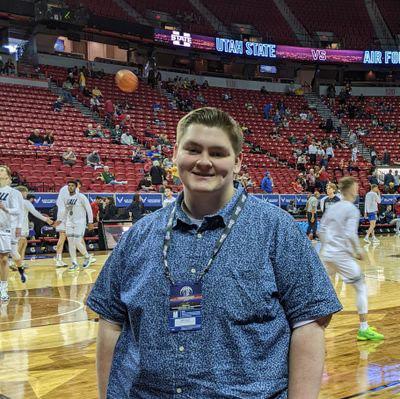





During July, the sky in Utah is often filled with bright fireworks from private and govern ment-sponsored firework celebrations in honor of both U.S. Independence Day and Pioneer Day.
However, with fire danger currently ranging from mod erate to extremely high through most of Utah, firework ignition could be subject to heavy restrictions.
According to the U.S. Drought Mon itor, Utah is experiencing a severe to excep tional drought throughout the state.
This means air quality is poor, natural bodies of water are low, ranching management practices have to change in order to ac commodate for the inadequate pasture and water for cattle, and fire danger increases.
During a drought, grass es and trees become so dry they catch fire more easily, and that fire can spread at an increased speed.
In response to the current drought and associated fire danger, many cities in Utah have set more rigid restrictions for when and how fireworks can be safely ignited.



Logan, being one of those cities, has changed firework ignition areas. Logan Fire Department assistant chief Craig Humphreys recommends every resident intending to light fireworks should check online to view the current restricted areas for their city prior to purchasing fire works.
Humphreys explained several different fire safety tips to help prevent firework fires during private holiday celebrations.
“Set your area up properly — pets are always a concern during fireworks, so make sure you know where your pets are and that they’re taken care of. Always have
water close by, and read and follow the directions on fireworks,” Humphreys said.
He went on to say that soaking your fireworks in a bucket of water after they’ve been discharged is extreme ly important.
“We have had probably the most fires I have seen from disposed fireworks — we’ve had dumpsters that ignite later on,” he said. “People will dispose of their firework debris in those [garbage cans] and then they’ll ignite and
“I think it’s important we follow the rules and guide lines the firefighters give us because they are the ones who have to clean up the mess and risk their lives when our actions cause problems,” Criddle said.
He explained how the fireworks at Fourth of July celebrations are important symbols of our nation’s freedom and heritage, so getting rid of the explosive lights shouldn’t be the answer; people learning to be safe should be.
“It helps me remember and appreciate what the early Americans had to go through for our freedom and independence,” Criddle said. “I think the fire works are a good way to honor those people and celebrate the in dependence they fought for.”
Visit firemar shall.utah.gov for more tips on how to safely ignite fireworks.
they’ll be in their garage or up against their house, and it spreads to the house.”
In addition to private celebrations, Logan City will be hosting firework shows on July 2 and July 23.
The Logan Fire Department has fire trucks on standby at these events and are prepared to handle potential emergencies.
“We will have additional people on duty for those eve nings, and hopefully everybody is sensible and follows the restrictions, and we don’t have any trouble,” Hum phreys stated.
Utah State University student and Logan resident Hunt er Criddle agreed that safety measures are important and said fire restrictions don’t take away the holiday fun — they keep the fun going.
Men have long dominated the fields of science and math throughout history and in mod ern times. Now, the statistics are changing, and more women are entering science, technology, engineering and math fields.
In the United States, 27% of STEM workers are women. In Utah, only 21% are women, according to research by the Utah Women and Leadership Project, or UWLP, founded by Susan Madsen through the Jon M. Huntsman Business College at Utah State University.

However, Utah has abundant opportu nities for STEM careers, as it is one of the top 10 states with job growth in science and technology. Salt Lake City ranks eighth out of the top 100 cities for tech growth.
The STEM workforce in the state of Utah is fast-growing, increasing by 20% since 2016. But while 10.5% of employed men are in a STEM field, only 3.4% of em ployed women are.
Madsen’s research within the UWLP shows that in the United States, the aver age salary for women in STEM is $30,000 less than their male counterparts.
And while men can work in STEM ca reers with a non-STEM bachelor’s degree, it has been proven that women nearly al ways have to gain a bachelor’s degree with in STEM to actually work in STEM fields.
Fortunately, UWLP’s research also shows that many organizations and programs have been making efforts to advance women in STEM careers.
“And it’s not just about gender,” Madsen said. “Companies that hire people with a range of ages, races, ethnic backgrounds and disabilities will be stronger for it. One recent study in Forbes showed that diverse teams make better decisions 87% of the time. And they make those decisions faster and with half the meetings.”
According to Madsen, diverse perspectives can benefit the workplace.
“Men and women have different ap proaches to addressing problems, with men tending to converge on issues to zero in a solution, while women prefer to diverge and explore many possible options,” Mad sen said. “Each approach is good, but a combination of approaches is better.”
Although most children have comparable abilities in science and math, many young
girls lose confidence in math by the third grade, as UWLP statistics report.
Women make up 47% of all workers in the United States, but the percentage of women in STEM fields is much lower: 27%. Still, this represents a 19% national increase since 1970.
Currently, UWLP research shows that women in STEM careers tend to be focused on life and social sciences and have lower participation in engineering and computer fields.
This all boils down to the fact that women are becoming more involved in STEM careers. Women are making great strides in science and technology fields, and the statistics predict they will continue to do so.
“Bottom line, while sameness may make us feel more comfortable, it is the enemy of innovation,” Madsen said.
Jillian Nelson is currently pursu ing her degree in psychology and journalism. In her free time, she loves to read and watch the latest Marvel movies with her family and friends.

— A02368712@usu.edu
Student-run newspaper for Utah State University since 1902. Reporting online 24/7. Printed weekly during the school year.
Utah Statesman, July 5, 2022
Darcy Ritchie managing editor editor@usustatesman.com 435-797-1742
Jacee Caldwell news manager news@usustatesman.com Jacob Ellis sports manager sports@usustatesman.com
Maya Mackinnon lifestyles manager life@usustatesman.com
Maren Archibald copy editor opinion@usustatesman.com
Bailey Rigby photo manager photo@usustatesman.com
Jaden Walker design manager design@usustatesman.com
For advertising inquiries studentmedia@usu.edu
Student Media Office TSC 118 435.797.1775
Cover art by Bailey Rigby
Fifty years ago, Title IX of the Education Amend ments of 1972 was signed into law by President Richard Nixon. Birch Bayh, a senator from Indi ana, penned the 37 words that changed athletics in the United States forever.
“No person in the United States shall, on the basis of sex, be excluded from participation in, be denied the benefits of, or be subjected to discrimination under any education program or activity receiving Federal financial assistance,” section A of the amendment reads.
Title IX is applied to athletic participation, scholarships and other benefits. The requirements guide institutions to equitable and proportional treatment of athletes, re gardless of gender. Like most other collegiate institu tions, Utah State receives federal funding and is thus responsible to adhere to Title IX.
“Everything we do in athletics, we are mindful of the Title IX implications,” said John Hartwell, USU’s Direc tor of Athletics.
For Hartwell and his staff, that means investing pro portionally in all athletics programs at Utah State. The Aggies have made these improvements across campus. For example, they have invested in new coaching hires, recruiting and nutrition programs. Utah State has also made efforts to upgrade its facilities with recent addi tions of the Wayne Estes Center, new turf for Maverick Stadium and LaRee and LeGrand Johnson Field, and plans to build a new $30 million indoor practice facility in the future.
“Our intention is to continue to invest in this area and try and make sure all of our sports are successful,” Hart well said. “It’s something that will benefit all of our stu dent-athletes.”
Sometimes, equitable and proportional investment can be seen as a limit on athletics. This is because schools have to balance investments and opportunities between the sexes to ensure compliance, which sometimes means schools sponsor fewer sports for one gender or forgo more expensive sports like football. Hartwell doesn’t see it this way, however.
“I don’t think it limits what you do,” Hartwell said. “I think that’s a glass-half-empty view of things. I think it promotes opportunities for female student-athletes.”
Amy Crosbie, USU’s Executive Associate Athletics Di rector for Internal Affairs, agreed with Hartwell.
“The nature of Title IX is to expand opportunities, not to remove them, and so in the spirit of Title IX, those who are looking to be compliant need to look to expand opportunities for whatever the underrepresented sex is,” Crosbie said.
Crosbie added that Title IX is “100%” the reason wom en have more opportunities and participate more than in the past.
“If you look pre-Title IX and now you look at post-Title IX, the opportunities for women to compete in athletics from the high school level to the collegiate level and into the professional level have expanded exponential ly,” Crosbie said.
That expansion included an opportunity for Crosbie
herself to play volleyball for Utah State from 1997 to 2000 on the team the Aggies started after Title IX took effect in the 1970s.
Current Utah State student-athletes and coaches agreed that Title IX has provided them opportunities that would not have been available without the legislation.
Olivia Wikstrom, a junior guard on the women’s basket ball team, said the 50th anniversary of Title IX helps her “reflect on how far women’s sports have come.”
“It just makes me feel really grateful for all the opportu nities that me and women today have in sports that they didn’t have in the past,” Wikstrom said.
Kayla Ard, head coach of USU’s women’s basketball team, added that she felt “kind of lucky” because she gets to “reap the benefits” of the progress made by the women before her.
While there have been substantial gains toward equality in the last 50 years, the USU community said there is still room to grow. Sara Taylor, a forward on the Aggie soccer team, said the biggest gap she sees between men’s and women’s sports is publicity.
“More people go to men’s sports and more people just know about them,” Taylor said. “I think people will come to women’s sports a little more if they’re advertised as much.”
Despite the gap, Taylor said she has seen efforts to in crease visibility grow during her time at USU.
“In the four years that I’ve been here, I’ve seen an increase in theamount of advertising for the women’s games,” Tay lor said. “It’s just continually getting better.”
Ard also thinks visibility for women’s sports is an issue that can be improved.
“I think anytime you can bring more awareness to wom en’s sports and female athletes, I think it’s a good thing,” Ard said. “The more we can bring awareness to women’s sports and help people to understand that these are very high-level athletes that work just as hard as the men ath letes do and their support means a lot to us.”
Last season, Ard took action and gave away money and food to promote attendance at her team’s games. She thinks promotions are important but added that performance is also key.
“You have to market it of course, and I also think you have to put a good product on the floor,” Ard said. “The more we market it and the better product we put on the floor, I think things will continue to rise in that aspect.”
Another area of focus to improve equality in sports is coaching. Jessica Evanson, an assistant coach for the soc cer team, said the world of coaching “still feels like a very male-dominated profession.” However, like advertising, she has seen movement in the right direction.
“I do see more female coaches being hired,” Evanson said.
“It’s trending in the right direction and I think over time it will level itself out to where you’re not being only hired because you’re a female, but because you are the top can didate and a female.”
Evanson added that she thinks improvements will contin ue to happen behind leaders pushing for equality.
“I’m grateful for those that are continually paving the way to continue to want change and to not settle for what’s be fore us,” Evanson said.
Overall, most Aggies seem to view Title IX as an impactful
tool that has helped and will continue to help Utah State move toward equality.
“We haven’t arrived, so it’s not like we’re exactly where we want to be, but we are where we are now because of Title IX, and we just need to continue to grow and evalu ate what the next 50 years are going to be,” Crosbie said.
“When they are
100th
we will be celebrating true equality.”
Jake Ellis is a senior studying broad cast journalism. When he’s not thinking about conference realignment or Utah Jazz trade rumors, he enjoys watching movies and going on drives.


Sudoku puzzles are provided by www.sudokuoftheday.com.








Last month’s solution:
